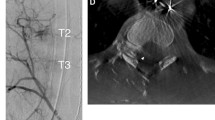Abstract
Background
As a vascular malformation, venous angioma in the spinal cord is extremely rare. To our knowledge, there are only five case reports in the literature, and it has not been previously reported in the pediatric age group.
Case report
In this paper, we report on a 3-year-old patient who presented with progressive weakness in his left upper limb. Spinal magnetic resonance imaging (MRI) revealed an epidural cystic mass at the C6–T2 level. The lesion was diagnosed as venous angioma after total removal with laminectomy. Postoperatively, the patient remained symptom free, and no tumor recurrence was confirmed based on MRI at the time of the 18-month follow-up. The clinical, radiological, surgical, and pathological features of this abnormality are discussed, and all six reported cases were reviewed.
Conclusion
Venous angiomas should be included in the differential diagnosis of spinal cystic lesions in children. A definitive diagnosis is difficult based on MRI alone. This rare lesion is amenable to surgery, and gross total removal (GTR) is usually achievable due to a well-demarcated dissection plane. A good clinical outcome after GTR can be expected.



Similar content being viewed by others
References
Arita H, Kishima H, Hosomi K, Iwaisako K, Hashimoto N, Saitoh Y, Yoshimine T (2012) Hemifacial spasm caused by intra-axial brainstem cavernous angioma with venous angiomas. Br J Neurosurg 26:281–283
Binkert CA, Kollias SS, Valavanis A (1999) Spinal cord vascular disease: characterization with fast three-dimensional contrast-enhanced MR angiography. AJNR Am J Neuroradiol 20:1785–1793
Decker RE, San Augustin W, Epstein JA (1978) Spinal epidural venous angioma causing foraminal enlargement and erosion of vertebral body. Case report. J Neurosurg 49:605–606
Dompmartin A, Vikkula M, Boon LM (2010) Venous malformation: update on aetiopathogenesis, diagnosis and management. Phlebology 25:224–235
Jellinger K (1986) Vascular malformations of the central nervous system: a morphological overview. Neurosurg Rev 9:177–216
Lee BB (2013) Venous malformation and haemangioma: differential diagnosis, diagnosis, natural history and consequences. Phlebology 28:176–187
Lee JW, Cho EY, Hong SH, Chung HW, Kim JH, Chang KH, Choi JY, Yeom JS, Kang HS (2007) Spinal epidural hemangiomas: various types of MR imaging features with histopathologic correlation. AJNR Am J Neuroradiol 28:1242–1248
Logue V (1979) Angiomas of the spinal cord: review of the pathogenesis, clinical features, and results of surgery. J Neurol Neurosurg Psychiatry 42:1–11
Mascalchi M, Quilici N, Ferrito G, Mangiafico S, Scazzeri F, Torselli P, Petruzzi P, Cosottini M, Tessa C, Bartolozzi C (1997) Identification of the feeding arteries of spinal vascular lesions via phase-contrast MR angiography with three-dimensional acquisition and phase display. AJNR Am J Neuroradiol 18:351–358
Nishimura Y, Hara M, Natsume A, Nakajima Y, Fukuyama R, Wakabayashi T, Ginsberg HJ (2013) Spinal intradural cystic venous angioma originating from a nerve root in the cauda equina. J Neurosurg Spine 19:716–720
Oya S, Prayson RA, Lee JH (2012) A tentorial venous hemangioma presenting as an extra-axial mass in the ambient cistern: a case report. J Neurol Surg Rep 73:37–40
Tomycz ND, Vora NA, Kanal E, Horowitz MB, Jovin TG (2010) Intracranial arterialized venous angioma: case report with new insights from functional brain MRI. Diagn Interv Radiol 16:13–15
Van Gompel JJ, Griessenauer CJ, Scheithauer BW, Amrami KK, Spinner RJ (2010) Vascular malformations, rare causes of sciatic neuropathy: a case series. Neurosurgery 67:1133–1142
Conflicts of interest
The authors have reported no conflicts of interest.
Author information
Authors and Affiliations
Corresponding author
Rights and permissions
About this article
Cite this article
Wu, L., Yang, T., Deng, X. et al. Spinal epidural venous angioma: a case report and review of the literature. Childs Nerv Syst 30, 1601–1605 (2014). https://doi.org/10.1007/s00381-014-2397-4
Received:
Accepted:
Published:
Issue Date:
DOI: https://doi.org/10.1007/s00381-014-2397-4




